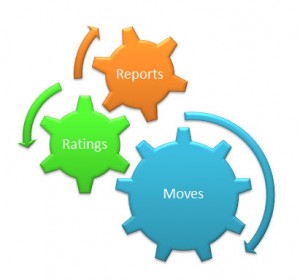 The future has a way of entering slowly, day-by-day. But sometimes the writing is on the wall. The words I see on the fundraising wall are Data Analytics. Sure, you say, we all know that. But what does it mean to your organization? To you? Answer: Innovate or die.
The future has a way of entering slowly, day-by-day. But sometimes the writing is on the wall. The words I see on the fundraising wall are Data Analytics. Sure, you say, we all know that. But what does it mean to your organization? To you? Answer: Innovate or die.
That may sound extreme. And it is. But it doesn’t make it any less possible. Before you dismiss that answer, let me tell you how I arrived at it.
The economic environment is affecting our donors – dramatically.
My favorite magazine of all time is The Economist. Lately they have been writing frequently about the growing inequality around the world and in America. How capital is taking a far greater share of wealth and how income, in the form of wages, is stagnating. Companies froze wages pre-recession, but even though profits have returned wages have not risen.
In his blog post “Where have all the donors gone?” Mark Noll makes the case that the result of these economics is the missing middle donor. Post-recession, people may be employed again, but too often at a lower wage. Where will our gifts come from?
In her book, Nonprofit Essentials: The Development Plan (2007), Linda Lysakowski, ACFRE is but one of many fundraisers talking about how Pareto’s 80/20 principle has turned into the 95/5 principle or worse. Way too much of our funding is coming from a tiny sliver of very wealthy. And where do the very wealthy like to give their gifts?
According to the Million Dollar List maintained by the Lilly Family School of Philanthropy, fifteen of the twenty largest multi-million dollar gifts by value were from individuals to private foundations associated with their families. Higher education receives the highest number of million dollar gifts.
In the Agitator blog, Roger Craver writes:
“Giving USA 2013 is but the latest report to make pretty clear that sitting on the sidelines waiting for recovery [from the Great Recession] is a strategy only for the suicidally inclined…demands on charities [is] rising at the same time giving is nearly flat….”
It’s pretty clear that if fundraisers fail to innovate the organizations they serve will suffer.
So what does all this gloom and doom have to do with data analytics?
Data analytics is the cold method behind a warm philosophy: listen to people when they tell you something. And when thousands of people are telling you something, not only listen, but start digging deeper and ask more questions.
Data analytics allows us to “hear” from our constituents in ways we are physically incapable of hearing. If the data tells us that a large number of constituents click through on messages about one of our program outcomes regardless of where we put those messages (social media, print, etc.), but are not responding to messages about another program we planned to make our strategic direction for the next year – we should re-think that direction, right? Maybe.
Analytics alone is not enough.
It’s pretty amazing that we can “hear” our constituents through data, but don’t be mesmerized by all that glitters. We also need innovation in our approach to attracting donors, finding the “best” out of those and asking them for gifts. If the reality is that we will mostly have very large and very small gifts, how can we change our approach?
In 2012 the Chronicle of Philanthropy featured the Kauffman Center for the Performing Arts in Missouri, which raised $416-million, in part by attracting modest gifts such as $1,000 multi-year pledges. This gave smaller donors the opportunity to express their interest and commitment and to be recognized. Crowdfunding is a similar approach, but might be improved upon to become less transactional. People want to give; people take pride in giving. It’s our job to figure out how to make it easy to give while building affinity.
In addition to gift size there are other changes we need to adapt to. Population changes cannot be ignored. Preeti Gill has written a provocative piece about identifying women philanthropists. In “Hey, Ladies! Thanks for giving. Sorry we missed you,” she notes that many multi-million dollar bequests come from women who are “outside of our databases and away from the corporate and media glare”. In other words, traditional prospect research techniques are failing to identify them.
International donors can’t be ignored either. Harvard University just announced a $350 million dollar gift from a wealthy Hong Kong family. Have you looked at population trends and predictions for your organization?
Are your donors from the local community? Are they international graduating students? You need fundraising programs that meet the needs of the constituents you have and will have in the future, not the ones you wish you could have. Data has to come from outside your organization as well as inside.
It’s All About the People
Data analytics helps us find answers and sometimes it can even help us ask questions, but most of the time data analytics requires someone with curiosity and creative problem-solving skills to direct it.
Fundraisers need to shake themselves awake from the traditional and begin interacting with the data so that they can better meet the philanthropic desires of (all) real people.
Organizations need to be willing to take risks, fail a little and ultimately win.
Ask Kodak or IBM about listening and innovating in the face of change. Innovate or die. It doesn’t sound so extreme now does it? And it is doable.
More Resources:
- As Wealthy Give Smaller Share of Income to Charity, Middle Class Digs Deeper | Chronicle of Philanthropy (2014)
- Donors From All Walks of Life Help Build Mo. Arts Center | Chronicle of Philanthropy (2012)
- Giving USA 2013: GoodNews … And Bad | Roger Craver (2013)
- Hey, Ladies! Thanks for giving. Sorry we missed you. | Preeti Gill (2014)
- Hong Kong Group to Give Harvard’s School of Public Health $350 Million | NY Times (2014)
- Million Dollar List | Lilly Family School of Philanthropy
- Nonprofit Essentials: The Development Plan | Linda Lysakowski (2007)
- To those that have shall be given: Labour is steadily losing out to capital, from Special Report: World Economy | The Economist (2014)
- Where Have All the Donors Gone | Mark Noll (2014)








